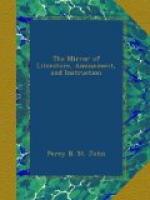“The author, by the kindness of a traveller,
recently returned from Egypt, has received a small
quantity of manna; it was, however, though still palatable,
in a liquid state, from the heat of the sun.
He has obtained the additional curious fact, that
manna, if not boiled or baked, will not keep more than
a day, but becomes putrid and breeds maggots.
It is described as a small round substance, and is
brought in by the Arabs in small quantities mixed with
sand.” It would appear from these very
interesting facts, that this exudation, which transpires
from the thorns or leaves of the tamarix, is altogether
different from the manna of the manna-ash. We
cannot doubt, from the entire coincidence in every
respect, that the manna found in the wilderness of
Sinai by the Arabs now, is identical with that
of the Scriptures. That the minute particulars
recorded should be every whit verified by modern research
and discovery, is worthy of great attention.
As Moses directed Aaron to “take a pot and put
an omer full of manna therein, and lay it up before
the LORD, (in the ark,) to be kept for the generations
of Israel,” as a memorial; so the remarkable
phenomenon remains in evidence of the truth of the
narrative. The miracle, however, remains
precisely as it was. There is sufficient to appeal
to, as an existing and perpetual memorial to all generations.
The MIRACLE, from which there can be no appeal, and
which allows of no equivocation, consisted in its
ample abundance, in its continued supply, and its
complete intermission on the sacred day of rest.
Nutritious substances have fallen from the atmosphere
in some countries; such, for example, was that which
fell a few years ago in Persia, and was examined by
Thenard. It proved to be a nutritious substance
referable to a vegetable origin. We have before
us, at the moment of writing these pages, a small work,
printed at Naples in 1793, the author of which is Gaetano
Maria La Pira; it is entitled, “Memoria sulla
pioggia della Manna,” &c.: and describes
a shower of manna which fell in Sicily, in the month
of September, 1792. The author, a professor of
chemistry, at Naples, gives an interesting account
of the circumstances under which it was found, together
with a variety of interesting particulars, some of
which we shall select, and we do so to prove that
a similar substance may have an aerial origin,
though carried up in the first instance, it may be,
by the process of evaporation;—this would
considerably modify the product. On the 26th September,
1792, a fall of manna took place at a district in
Sicily, called Fiume grande; this singular
shower lasted, it is stated, for about an hour and
a half. It commenced at twenty-two o’clock,
according to Italian time, or about five o’clock
in the afternoon: the space covered with this
manna seems to have been considerable. A second
shower covered a space of thirty-eight paces in length,
by fourteen in breadth. This second shower of




